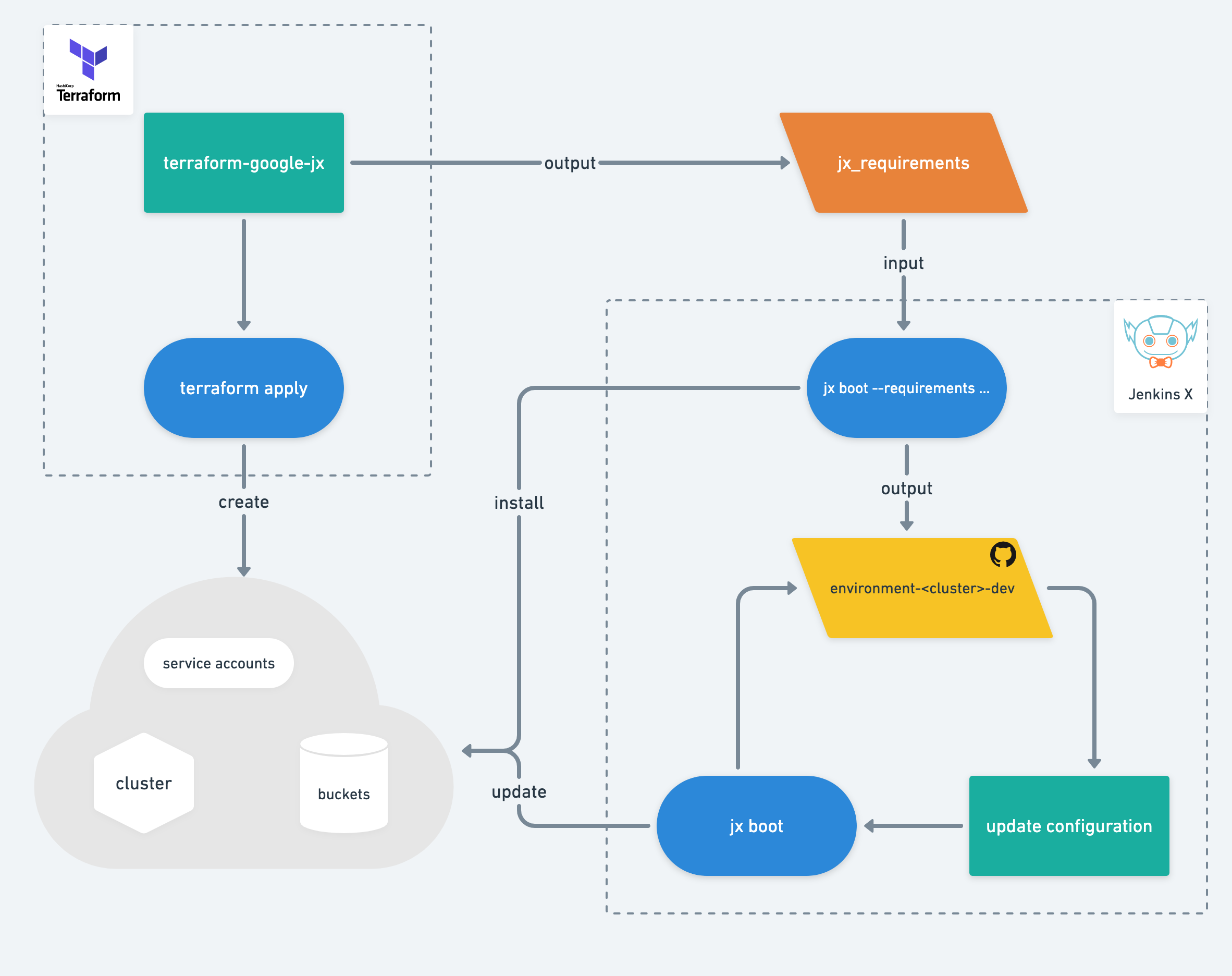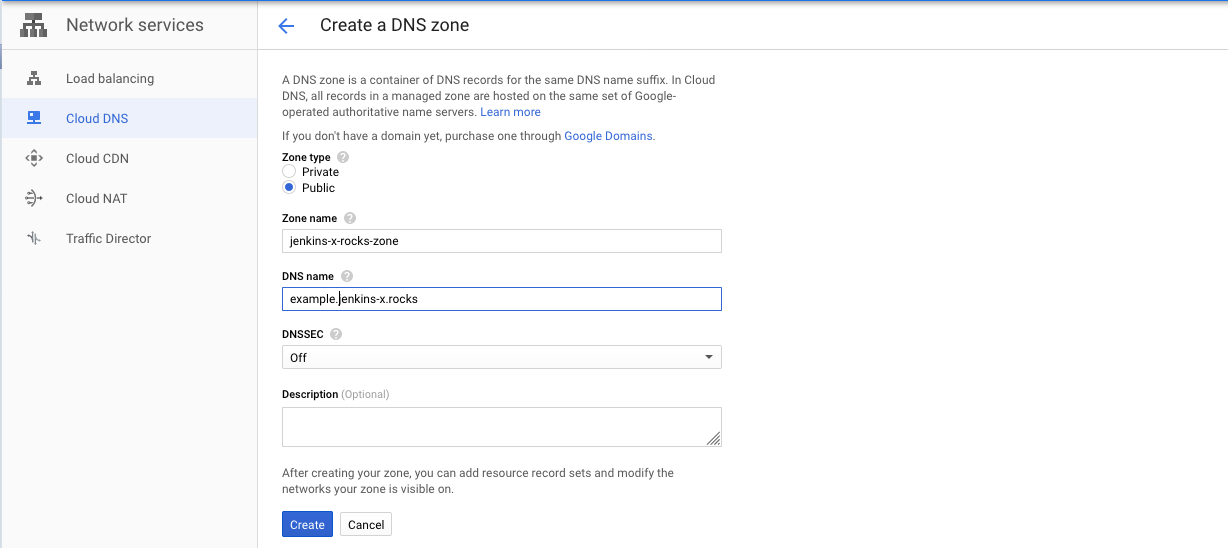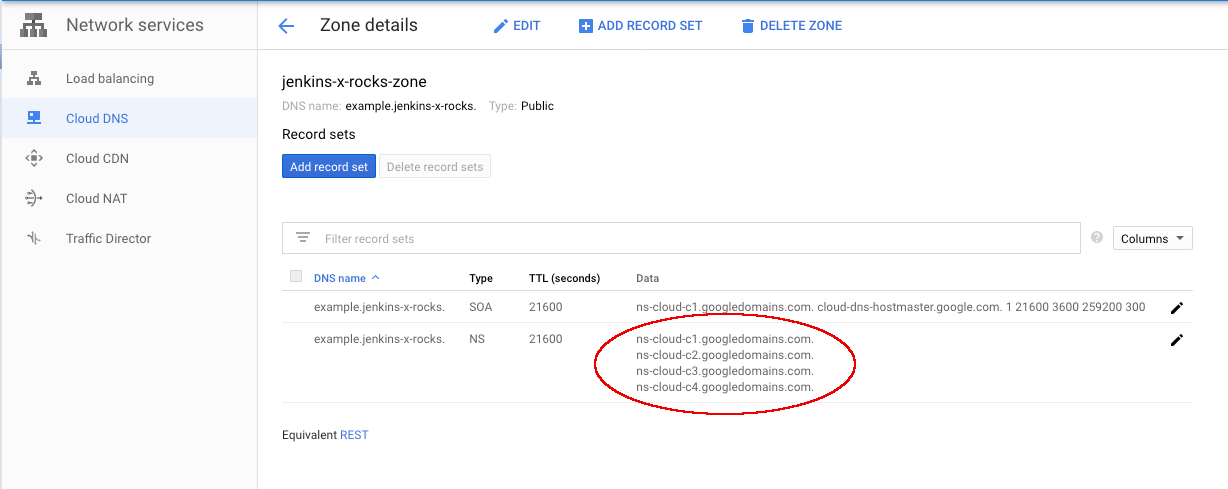NOTE: While the required minimum Terraform version is 0.12.0, automated CI tests are performed with 0.13 only. The only expected compatibility issues to be aware of are around provider requirements. For more information see here
This repo contains a Terraform module for provisioning a Kubernetes cluster for Jenkins X on Google Cloud.
- Jenkins X GKE Module
A Terraform "module" refers to a self-contained package of Terraform configurations that are managed as a group. For more information around modules refer to the Terraform documentation.
To make use of this module, you need a Google Cloud project. Instructions on how to setup such a project can be found in the Google Cloud Installation and Setup guide. You need your Google Cloud project id as an input variable for using this module.
You also need to install the Cloud SDK, in particular gcloud.
You find instructions on how to install and authenticate in the Google Cloud Installation and Setup guide as well.
Once you have gcloud installed, you need to create Application Default Credentials by running:
gcloud auth application-default loginAlternatively, you can export the environment variable GOOGLE_APPLICATION_CREDENTIALS referencing the path to a Google Cloud service account key file.
Last but not least, ensure you have the following binaries installed:
gcloudkubectl~> 1.14.0kubectlcomes bundled with the Cloud SDK
terraform~> 0.12.0- Terraform installation instruction can be found here
A default Jenkins X ready cluster can be provisioned by creating a file main.tf in an empty directory with the following content:
module "jx" {
source = "jenkins-x/jx/google"
gcp_project = "<my-gcp-project-id>"
}
output "jx_requirements" {
value = module.jx.jx_requirements
} You can then apply this Terraform configuration via:
terraform init
terraform applyThis creates a cluster within the specified Google Cloud project with all possible configuration options defaulted.
On completion of terraform apply a jx_requirements output is available which can be used as input to jx boot.
Refer to Running jx boot for more information.
In the default configuration, no custom domain is used. DNS resolution occurs via nip.io. For more information on how to configure and use a custom domain, refer to Using a custom domain.
If you just want to experiment with Jenkins X, you can set force_destroy to true.
This allows you to remove all generated resources when running terraform destroy, including any generated buckets including their content.
The following two paragraphs provide the full list of configuration and output variables of this Terraform module.
| Name | Description | Type | Default | Required |
|---|---|---|---|---|
| apex_domain | The parent / apex domain to be used for the cluster | string |
"" |
no |
| apex_domain_gcp_project | The GCP project the apex domain is managed by, used to write recordsets for a subdomain if set. Defaults to current project. | string |
"" |
no |
| apex_domain_integration_enabled | Flag that when set attempts to create delegation records in apex domain to point to domain created by this module | bool |
true |
no |
| bucket_location | Bucket location for storage | string |
"US" |
no |
| cluster_location | The location (region or zone) in which the cluster master will be created. If you specify a zone (such as us-central1-a), the cluster will be a zonal cluster with a single cluster master. If you specify a region (such as us-west1), the cluster will be a regional cluster with multiple masters spread across zones in the region | string |
"us-central1-a" |
no |
| cluster_name | Name of the Kubernetes cluster to create | string |
"" |
no |
| cluster_network | The name of the network (VPC) to which the cluster is connected | string |
"default" |
no |
| cluster_subnetwork | The name of the subnetwork to which the cluster is connected. Leave blank when using the 'default' vpc to generate a subnet for your cluster | string |
"" |
no |
| create_ui_sa | Whether the service accounts for the UI should be created | bool |
true |
no |
| dev_env_approvers | List of git users allowed to approve pull request for dev enviornment repository | list(string) |
[] |
no |
| enable_backup | Whether or not Velero backups should be enabled | bool |
false |
no |
| enable_private_endpoint | (Beta) Whether the master's internal IP address is used as the cluster endpoint. Requires VPC-native | bool |
false |
no |
| enable_private_nodes | (Beta) Whether nodes have internal IP addresses only. Requires VPC-native | bool |
false |
no |
| force_destroy | Flag to determine whether storage buckets get forcefully destroyed | bool |
false |
no |
| gcp_project | The name of the GCP project to use | string |
n/a | yes |
| git_owner_requirement_repos | The git id of the owner for the requirement repositories | string |
"" |
no |
| gsm | Enables Google Secrets Manager, not available with JX2 | bool |
false |
no |
| ip_range_pods | The IP range in CIDR notation to use for pods. Set to /netmask (e.g. /18) to have a range chosen with a specific netmask. Enables VPC-native | string |
"" |
no |
| ip_range_services | The IP range in CIDR notation use for services. Set to /netmask (e.g. /21) to have a range chosen with a specific netmask. Enables VPC-native | string |
"" |
no |
| jenkins_x_namespace | Kubernetes namespace to install Jenkins X in | string |
"jx" |
no |
| jx2 | Is a Jenkins X 2 install | bool |
true |
no |
| jx_bot_token | Bot token used to interact with the Jenkins X cluster git repository | string |
"" |
no |
| jx_bot_username | Bot username used to interact with the Jenkins X cluster git repository | string |
"" |
no |
| jx_git_operator_version | The jx-git-operator helm chart version | string |
"0.0.192" |
no |
| jx_git_url | URL for the Jenins X cluster git repository | string |
"" |
no |
| kuberhealthy | Enables Kuberhealthy helm installation | bool |
true |
no |
| lets_encrypt_production | Flag to determine wether or not to use the Let's Encrypt production server. | bool |
true |
no |
| master_authorized_networks | List of master authorized networks. If none are provided, disallow external access (except the cluster node IPs, which GKE automatically allowlists). | list(object({ cidr_block = string, display_name = string })) |
[] |
no |
| master_ipv4_cidr_block | The IP range in CIDR notation to use for the hosted master network. This range must not overlap with any other ranges in use within the cluster's network, and it must be a /28 subnet | string |
"10.0.0.0/28" |
no |
| max_node_count | Maximum number of cluster nodes | number |
5 |
no |
| max_pods_per_node | Max gke nodes = 2^($CIDR_RANGE_PER_NODE-$POD_NETWORK_CIDR) (see gke docs) | number |
64 |
no |
| min_node_count | Minimum number of cluster nodes | number |
3 |
no |
| node_disk_size | Node disk size in GB | string |
"100" |
no |
| node_disk_type | Node disk type, either pd-standard or pd-ssd | string |
"pd-standard" |
no |
| node_machine_type | Node type for the Kubernetes cluster | string |
"n1-standard-2" |
no |
| node_preemptible | Use preemptible nodes | bool |
false |
no |
| node_spot | Use spot nodes | bool |
false |
no |
| parent_domain | **Deprecated** Please use apex_domain variable instead.r | string |
"" |
no |
| parent_domain_gcp_project | **Deprecated** Please use apex_domain_gcp_project variable instead. | string |
"" |
no |
| release_channel | The GKE release channel to subscribe to. See https://cloud.google.com/kubernetes-engine/docs/concepts/release-channels | string |
"REGULAR" |
no |
| resource_labels | Set of labels to be applied to the cluster | map(any) |
{} |
no |
| subdomain | Optional sub domain for the installation | string |
"" |
no |
| tls_email | Email used by Let's Encrypt. Required for TLS when apex_domain is specified | string |
"" |
no |
| vault_url | URL to an external Vault instance in case Jenkins X shall not create its own system Vault | string |
"" |
no |
| velero_namespace | Kubernetes namespace for Velero | string |
"velero" |
no |
| velero_schedule | The Velero backup schedule in cron notation to be set in the Velero Schedule CRD (see default-backup.yaml) | string |
"0 * * * *" |
no |
| velero_ttl | The the lifetime of a velero backup to be set in the Velero Schedule CRD (see default-backup.yaml) | string |
"720h0m0s" |
no |
| version_stream_ref | The git ref for version stream to use when booting Jenkins X. See https://jenkins-x.io/docs/concepts/version-stream/ | string |
"master" |
no |
| version_stream_url | The URL for the version stream to use when booting Jenkins X. See https://jenkins-x.io/docs/concepts/version-stream/ | string |
"https://github.com/jenkins-x/jenkins-x-versions.git" |
no |
| webhook | Jenkins X webhook handler for git provider | string |
"lighthouse" |
no |
| zone | Zone in which to create the cluster (deprecated, use cluster_location instead) | string |
"" |
no |
| Name | Description |
|---|---|
| backup_bucket_url | The URL to the bucket for backup storage |
| cluster_location | The location of the created Kubernetes cluster |
| cluster_name | The name of the created Kubernetes cluster |
| connect | The cluster connection string to use once Terraform apply finishes |
| externaldns_dns_name | ExternalDNS name |
| externaldns_ns | ExternalDNS nameservers |
| gcp_project | The GCP project in which the resources got created |
| jx_requirements | The jx-requirements rendered output |
| log_storage_url | The URL to the bucket for log storage |
| report_storage_url | The URL to the bucket for report storage |
| repository_storage_url | The URL to the bucket for artifact storage |
| tekton_sa_email | The Tekton service account email address, useful to provide further IAM bindings |
| tekton_sa_name | The Tekton service account name, useful to provide further IAM bindings |
| vault_bucket_url | The URL to the bucket for secret storage |
A terraform output (jx_requirements) is available after applying this Terraform module.
terraform output jx_requirementsThis jx_requirements output can be used as input to Jenkins X Boot which is responsible for installing all the required Jenkins X components into the cluster created by this module.
jx boot.
During this first run of jx boot a git repository containing the source code for Jenkins X Boot is created.
This (new) repository contains a jx-requirements.yml (which is now ahead of the jx-requirements output from terraform) used by successive runs of jx boot.
Execute:
terraform output jx_requirements > <some_empty_dir>/jx-requirements.yml
# jenkins-x creates the environment repository directory localy before pushing to the Git server of choice
cd <some_empty_dir>
jx boot --requirements jx-requirements.ymlYou are prompted for any further required configuration. The number of prompts depends on how much you have pre-configured via your Terraform variables.
If you want to use a custom domain with your Jenkins X installation, you need to provide values for the variables apex_domain and tls_email. apex_domain is the fully qualified domain name you want to use and tls_email is the email address you want to use for issuing Let's Encrypt TLS certificates.
Before you apply the Terraform configuration, you also need to create a Cloud DNS managed zone, with the DNS name in the managed zone matching your custom domain name, for example in the case of example.jenkins-x.rocks as domain:
When creating the managed zone, a set of DNS servers get created which you need to specify in the DNS settings of your DNS registrar.
It is essential that before you run jx boot, your DNS servers settings are propagated, and your domain resolves.
You can use DNS checker to check whether your domain settings have propagated.
When a custom domain is provided, Jenkins X uses ExternalDNS together with cert-manager to create A record entries in your managed zone for the various exposed applications.
If apex_domain id not set, your cluster will use nip.io in order to create publicly resolvable URLs of the form http://<app-name>-<environment-name>.<cluster-ip>.nip.io.
The configuration as seen in Cluster provisioning is not suited for creating and maintaining a production Jenkins X cluster. The following is a list of considerations for a production usecase.
-
Specify the version attribute of the module, for example:
module "jx" { source = "jenkins-x/jx/google" version = "1.2.4" # insert your configuration } output "jx_requirements" { value = module.jx.jx_requirements }
Specifying the version ensures that you are using a fixed version and that version upgrades cannot occur unintented.
-
Keep the Terraform configuration under version control, by creating a dedicated repository for your cluster configuration or by adding it to an already existing infrastructure repository.
-
Setup a Terraform backend to securely store and share the state of your cluster. For more information refer to Configuring a Terraform backend.
A "backend" in Terraform determines how state is loaded and how an operation such as apply is executed. By default, Terraform uses the local backend which keeps the state of the created resources on the local file system. This is problematic since sensitive information will be stored on disk and it is not possible to share state across a team. When working with Google Cloud a good choice for your Terraform backend is the gcs backend which stores the Terraform state in a Google Cloud Storage bucket. The examples directory of this repository contains configuration examples for using the gcs backed with and without optionally configured customer supplied encryption key.
To use the gcs backend you will need to create the bucket upfront.
You can use gsutil to create the bucket:
gsutil mb gs://<my-bucket-name>/It is also recommended to enable versioning on the bucket as an additional safety net in case of state corruption.
gsutil versioning set on gs://<my-bucket-name>You can verify whether a bucket has versioning enabled via:
gsutil versioning get gs://<my-bucket-name>terraform init -upgradeprovider "google" {
version = "~> 2.12.0"
project = var.gcp_project
}
provider "google-beta" {
version = "~> 2.12.0"
project = var.gcp_project
}The recommended way to authenticate to the Google Cloud API is by using a service account.
This allows for authentication regardless of where your code runs.
This Terraform module expects authentication via a service account key.
You can either specify the path to this key directly using the GOOGLE_APPLICATION_CREDENTIALS environment variable or you can run gcloud auth application-default login.
In the latter case gcloud obtains user access credentials via a web flow and puts them in the well-known location for Application Default Credentials (ADC), usually ~/.config/gcloud/application_default_credentials.json.
At the moment there is no release pipeline defined in jenkins-x.yml.
A Terraform release does not require building an artifact, only a tag needs to be created and pushed.
To make this task easier and there is a helper script release.sh which simplifies this process and creates the changelog as well:
./scripts/release.shThis can be executed on demand whenever a release is required. For the script to work the envrionment variable $GH_TOKEN must be exported and reference a valid GitHub API token.
Contributions are very welcome! Check out the Contribution Guidelines for instructions.



